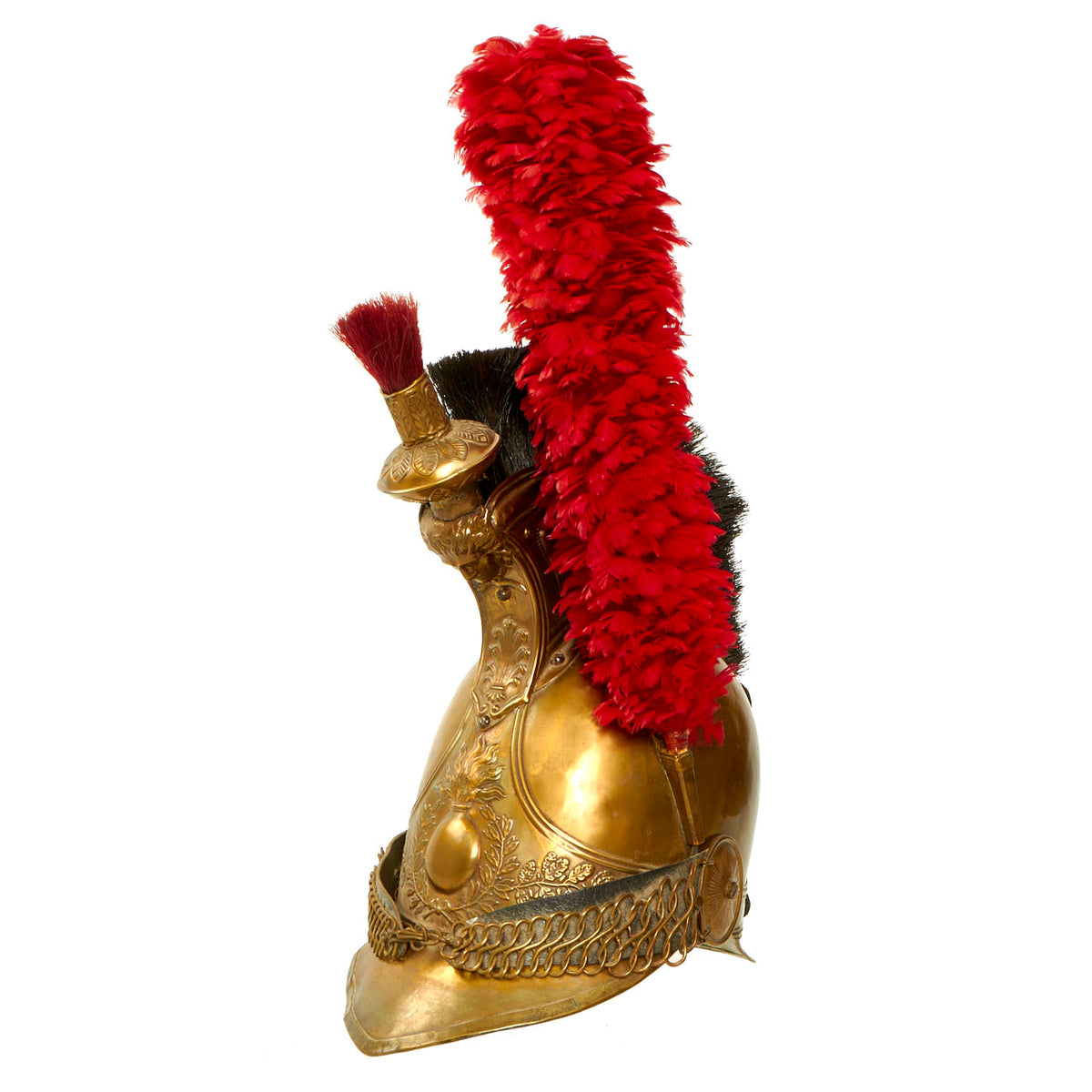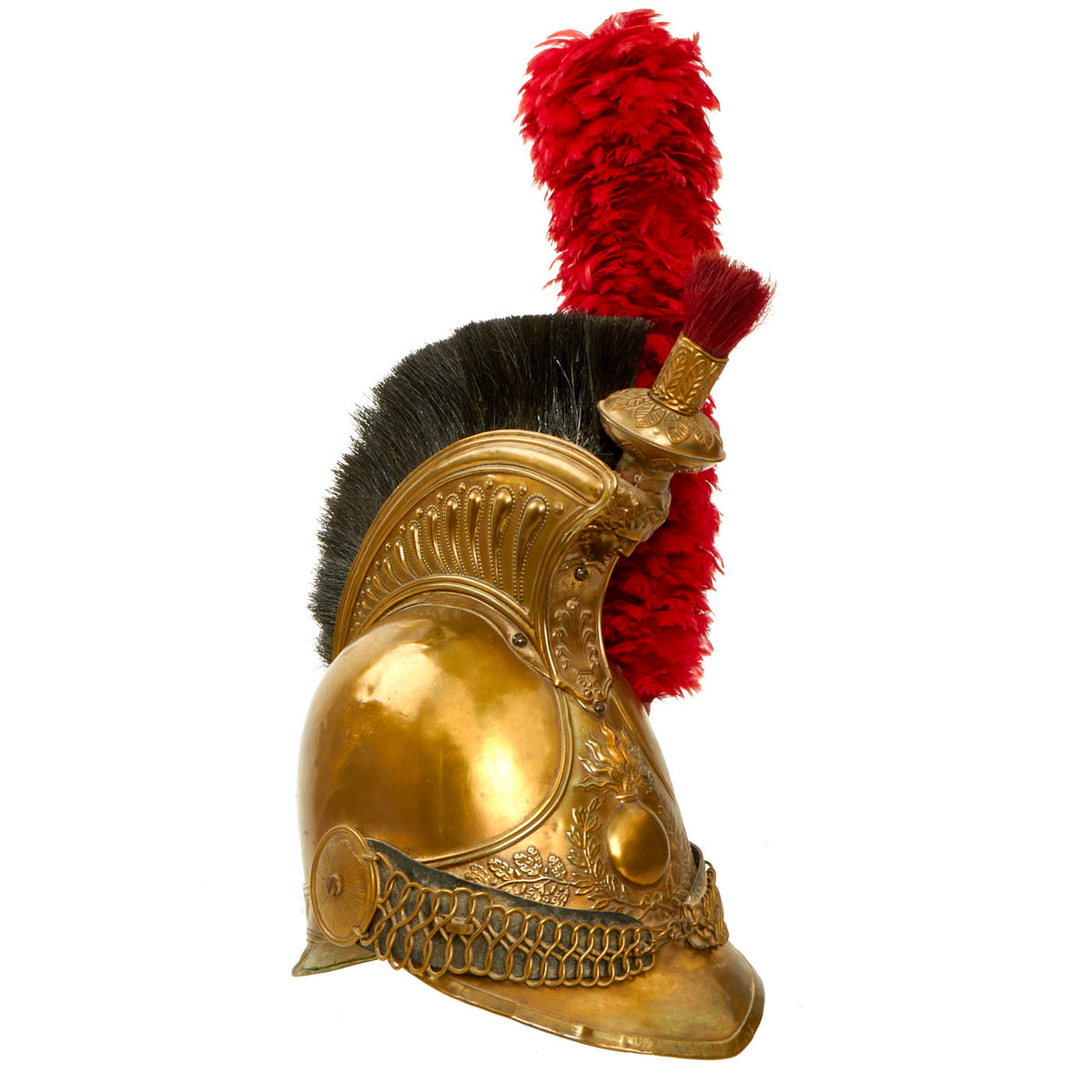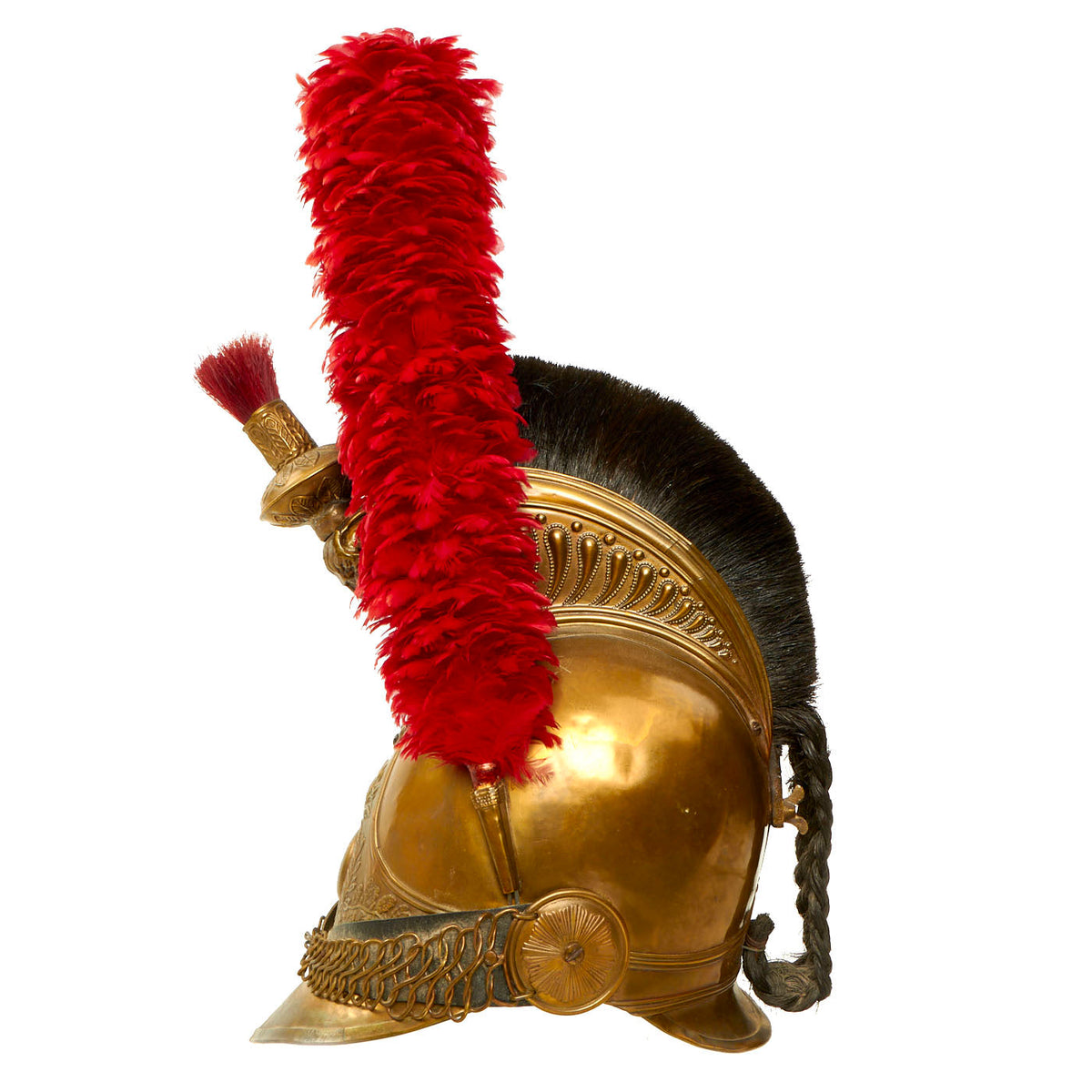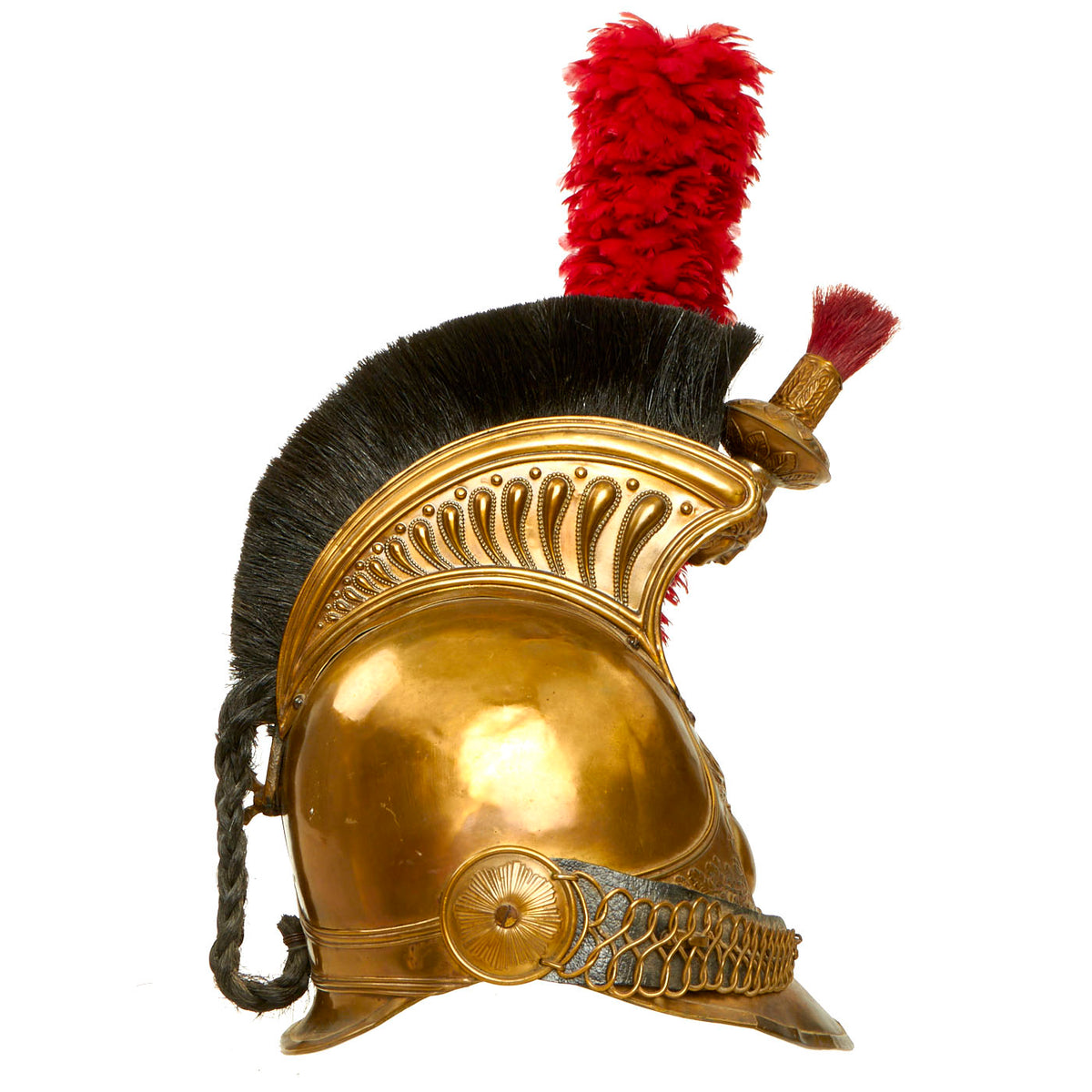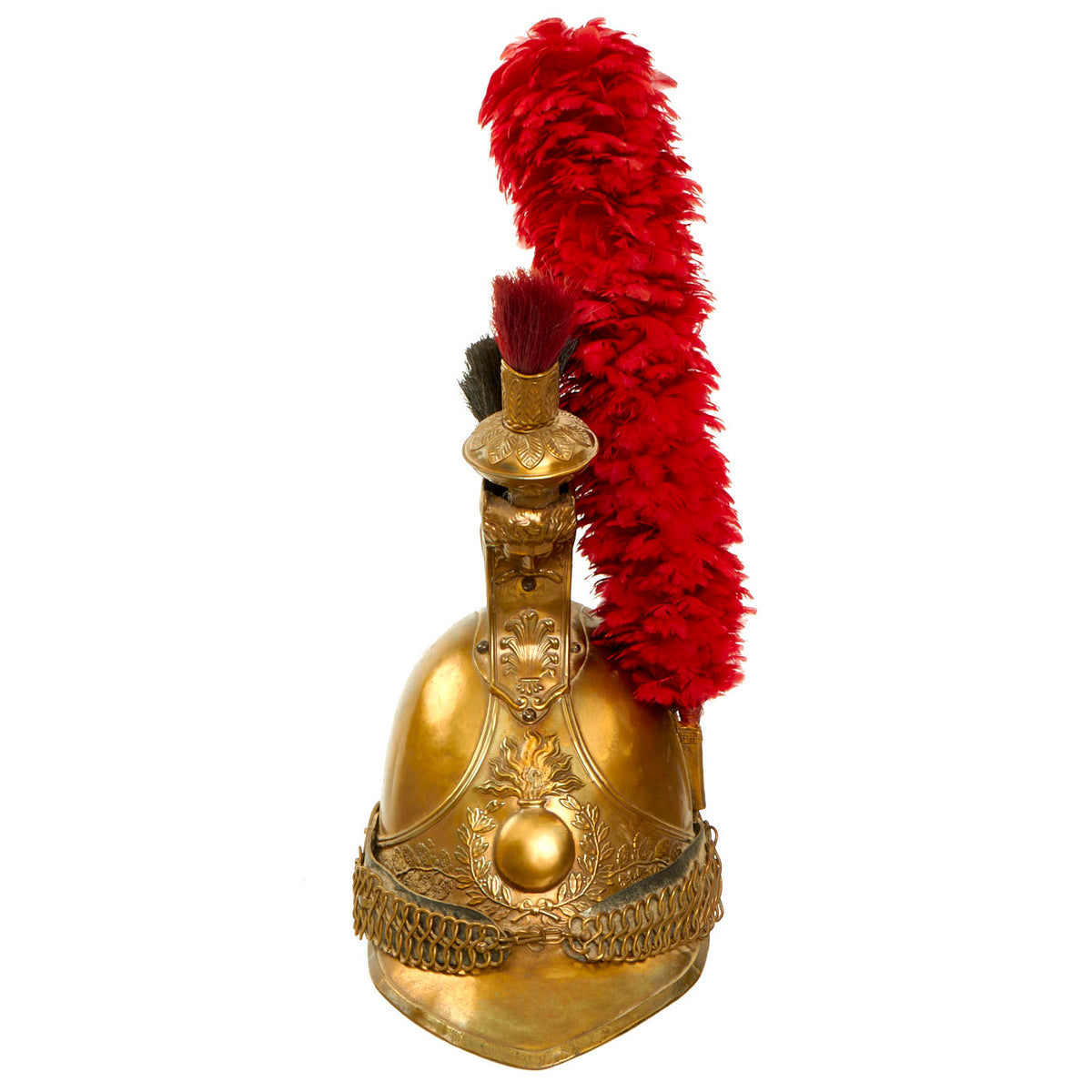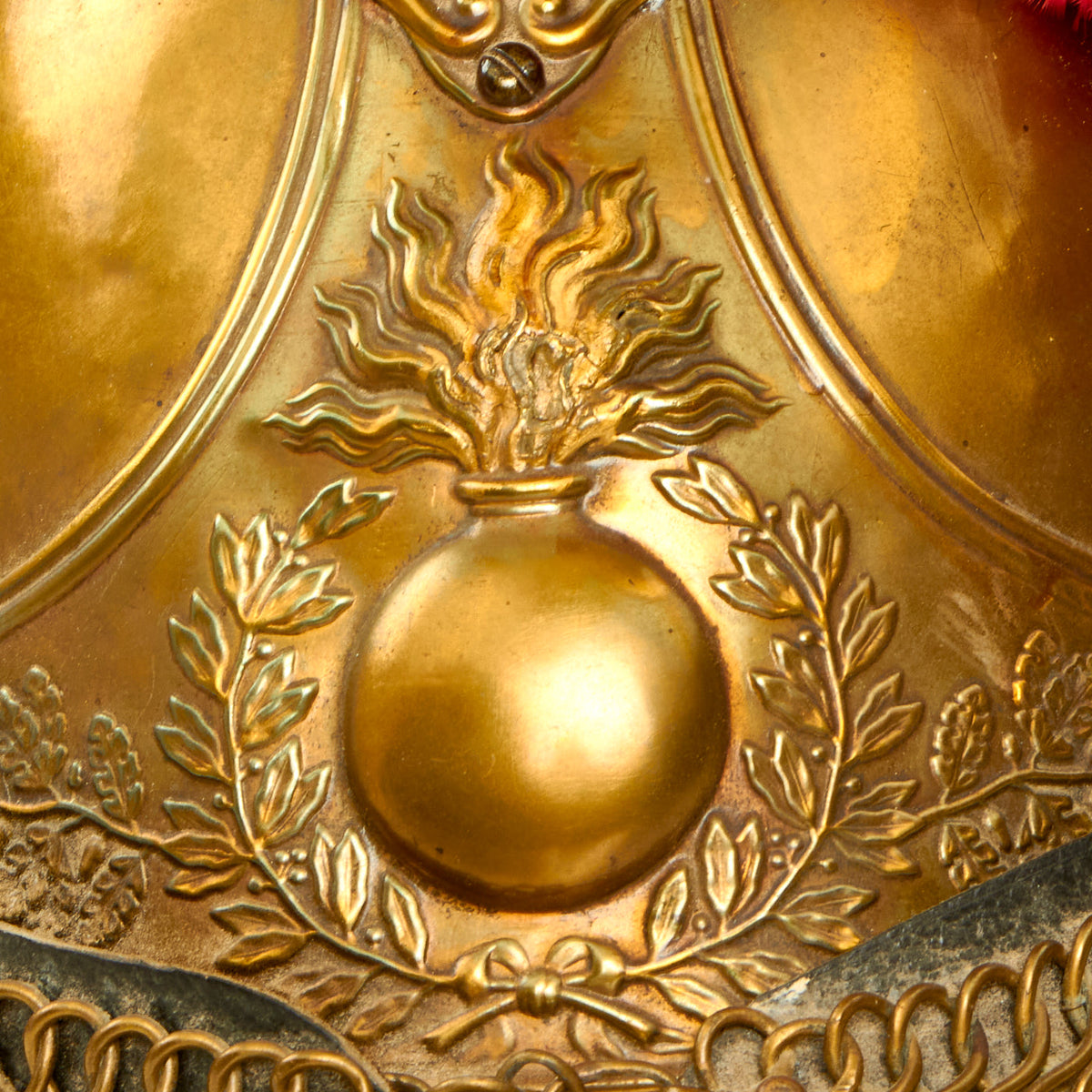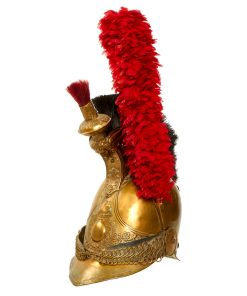Original French 2nd Empire Model 1825 Carabinier Brass Helmet Original Items
$ 3.495,00 $ 873,75
Original Item: Only One Available. This is a wonderful French Model 1825 Carabinier Helmet, with brass skull, brass comb embossed with beaded fluting and terminating with the head of Medusa, and black horsehair mane. The brass helmet plate is embossed with a flaming grenade flanked by laurel leaves, with brass bound front and back peaks. It still retains the leather backed brass overlapping chin strap, which are still fully intact, though worn. The left side of the skull bears a red feather plume with black base knot, alas the black base knot is missing.
The original leather liner is unfortunately missing, however, the threaded posts for attachment are still mostly serviceable and if you would wish to do so you can partially attach a replacement liner. There are not dates of markings present on the helmet aside from what appears to be a serial number stamped into the brass on the back of the helmet. The numbers appear as 31 on the left side and 343 present on the right. The overall condition is impeccable for the age with only the liner missing.
Items such as this one, in this condition are seldom encountered and you do not want to miss the opportunity to add this one to your collection!
Comes more than ready for further research and display.
A carabinier (also sometimes spelled carabineer or carbineer) is in principle a soldier armed with a carbine. A carbiniere is a carabiniere musket or rifle and were commonplace by the beginning of the Napoleonic Wars in Europe. The word is derived from the identical French word carabinier.
Historically, carabiniers were generally (but not always) horse soldiers. The carbine was considered a more appropriate firearm for a horseman than a full-length musket, since it was lighter and easier to handle while on horseback. Light infantry sometimes carried carbines because they are less encumbering when moving rapidly, especially through vegetation, but in most armies the tendency was to equip light infantry with longer-range weapons such as rifles rather than shorter-range weapons such as carbines. In Italy and Spain, carbines were considered suitable equipment for soldiers with policing roles, so the term carabinier evolved to sometimes denote gendarmes and border guards.
Today, the term is used by some countries in military, law enforcement, and gendarmerie roles.
French Carabiniers-à-Cheval
In 1690 one company of carabiniers was maintained in each regiment of the French army’s cavalry. Their duties were analogous to those of grenadiers in infantry regiments: scouting, detached work, and, in general, all duties requiring special activity and address. They fought mounted and dismounted alike, and even took part in siege warfare in the trenches. The French carabiniers were mentioned at the battle of Neerwinden in 1693 commanded by Prince de Conti. Although their original role was that of a mounted police similar to the Gendarmes, as combat troops they first took the form of separate companies within each cavalry regiments on 29 October 1691 under Louis XIV. Only later was an independent regiment or cavalerie de reserve established in 1693 under the command of Duc du Maine. However at that time all French cavalry other than the gendarmes were called light cavalry, and their first name was Corps royal des carabiniers, organized by brigading of four squadrons commanded by a lieutenant-colonel.
The Corps was enlarged to ten squadrons by the start of the Seven Years’ War. Their depot was in Strasbourg, where it remained for a century. On 13 May 1758, the Corps was renamed Royal carabiniers de monsieur le Comte de Provence. By 1762, the Corps was enlarged to five brigades of thirty squadrons, but was reduced to two regiments in 1788. However, the events of the French Revolution affected all of the French Army and the cavalry Arm in particular, and the carabiniers were reduced to two regiments of four squadrons each, later serving in the Army of the Rhine. The regiments retained their distinctive bearskin headwear until 1810 when it was replaced by even more distinctive helmets with scarlet combs. They were also distinguished by Napoleon with a brass overlay on the iron cuirasses after suffering heavy casualties in the 1809 campaign, but were no longer equipped with carbines.
The two Carabiniers regiments, brigaded together and as a part of General of Division Nansouty’s 1st Heavy Cavalry Division saw action during the Napoleonic wars, including in the Battle of Austerlitz, Battle of Friedland, Battle of Wagram, Battle of Borodino (commanded by General of Brigade Defrance), Battle of Leipzig, Battle of Laon and Battle of Waterloo. The Carabiniers were restored as a single régiment de Monsieur after the second Bourbon restoration.
By 1814, there were two regiments of Carabiniers with their distinctive style of helmet, which was temporarily adopted by the cuirassiers. The Carabiniers were present in Paris in June 1848 for the creation of the Republic, when nine regiments were brought in to maintain peace, the first time in 200 years that carabiniers were again serving as military police. From 1852 the Carabiniers were a part of the Army of the Second French Empire, but did not serve in the Crimean War. In 1870, they saw service again as a single regiment, but now as part of the Imperial Guard. Following the Franco-Prussian War, the Carabiniers were amalgamated with the 11th Cuirassier regiment on 4 February 1871.
The 1-11e Régiment de Cuirassiers of the modern French Army can accordingly trace its origin, in part, to the 19th Century Carabiniers. By coincidence the present day regiment is stationed in Carpiagne within Provence, once the domain of their former commander.
Fast Shipping with Professional Packaging
Thanks to our longstanding association with UPS FedEx DHL, and other major international carriers, we are able to provide a range of shipping options. Our warehouse staff is expertly trained and will wrap your products according to our exact and precise specifications. Prior to shipping, your goods will be thoroughly examined and securely secured. We ship to thousands clients each day across multiple countries. This shows how we're dedicated to be the largest retailer on the internet. Warehouses and distribution centres can be located throughout Europe as well as the USA.
Note: Orders with more than one item will be assigned a processing date depending on the item.
Before shipping before shipping, we'll conduct a thorough inspection of the items you have ordered. Today, the majority of orders will be delivered within 48 hours. The delivery time will be between 3-7 days.
Returns
The stock is dynamic and we cannot completely manage it because multiple stakeholders are involved, including our factory and warehouse. So the actual stock may alter at any time. It's possible that you may not receive your order once the order has been made.
Our policy is valid for a period of 30 days. If you don't receive the product within 30 days, we are not able to issue a refund or an exchange.
You can only return an item if it is unused and in the same state as the day you received it. You must have the item in its original packaging.
Related products
Uncategorized
Band of Brothers ORIGINAL GERMAN WWII Le. F.H. 18 10.5cm ARTILLERY PIECE Original Items
Uncategorized
Uncategorized
Australian WWII Owen MK1 Machine Carbine SMG Custom Fabricated Replica with Sling Original Items
Uncategorized
Angolan Rebel 1970s era 60mm Inert Display Mortar from Angolan Civil War Original Items
Uncategorized
Uncategorized
Uncategorized
Uncategorized
Uncategorized
Uncategorized
Uncategorized
Armored Burgonet Helmet & Polearm from Scottish Castle Leith Hall Circa 1700 Original Items
Uncategorized
Uncategorized
Uncategorized
Uncategorized
Uncategorized
Armoured Fighting Vehicles of the World: AFVs of World War One (Hardcover Book) New Made Items
Uncategorized
Uncategorized
